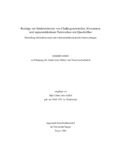Citation link:
https://nbn-resolving.org/urn:nbn:de:hbz:467-2162Files in This Item:
| File | Description | Size | Format | |
|---|---|---|---|---|
| schlirf.pdf | 41.36 MB | Adobe PDF |  View/Open |
| Dokument Type: | Doctoral Thesis | metadata.dc.title: | Beiträge zur Strukturchemie von Chalkogenotetrelen, Mercuraten und supramolekularen Netzwerken mit Quecksilber : Darstellung, Kristallstrukturen und elektronenmikroskopische Untersuchungen | Authors: | Schlirf, Jens | Institute: | Fachbereich 8, Chemie - Biologie | Free keywords: | germanates, mercurates, supramolecular frameworks | Dewey Decimal Classification: | 540 Chemie | GHBS-Clases: | UOF | Issue Date: | 2006 | Publish Date: | 2006 | Abstract: | Auf der Basis optimierter Syntheseverfahren der Festkorperchemie (u.a. der kontrollierten thermischen Zersetzung von Alkalimetallaziden) werden neue Chalkogenotetrele und -mercurate dargestellt, festkorperchemisch charakterisiert und hinsichtlich weiterführender Aspekte mit ihrem strukturchemischen Umfeld verglichen. Die folgenden neuen gemischtvalenten Chalkogenotetrele der Alkalimetalle wurden ausgehend von den zuvor dargestellten Alkalimetallchalkogeniden (A 2 X, A: Alkalimetall, X: Chalkogen) erhalten: K 2 Sn 4 S 8 , K 2 Sn 3 GeS 8 , K 2 Sn 2 Ge 2 S 8 und K 2 SnGe 3 S 8 . Diese Verbindungen zeigen für Tetrelatome typische, ihren Oxidationsstufen entsprechende Polyeder, wie z.B. tetraedrische bzw. φ-trigonal bipyramidale Koordination für die vier- bzw. zweiwertige Spezies. Systematische Auswertungen der Resultate von Einkristallstrukturanalysen ergaben keine Hinweise auf eine Substitution von Sn(II) durch Germanium bzw. auf die Existenz der Randphase K 2 Ge 4 S 8 . Im Rahmen von Untersuchungen auf den quasibinären Schnitten A 2 X-HgX (A = Na, K; X = S, Se, Te) konnte eine Neubestimmung der Kristallstruktur von K 2 Hg 3 Se 4 erfolgen. Diese ist durch eindimensional unendliche HgSe 4/2 (HgSe 2/2 ) 2 -Stränge gekennzeichnet, die über sekundäre Wechselwirkungen pseudo-Schichten ausbilden. Eine Separation der Schichten erfolgt durch die Alkalimetallionen. Auf dem Gebiet der quecksilberhaltigen Wirt-Gast-Verbindungen konnten mit [Hg 6 Z 4 ](InBr 6 )Br (Z = As, Sb) zwei neue, zu [Hg 6 Sb 4 ](SbBr 6 )Br isotype Verbindungen dargestellt und charakterisiert werden. Das kationische Netzwerk dieser Verbindungen basiert auf einer dreidimensionalen Verknüpfung von ethananalogen Z 2 Hg 6/2 -Einheiten. Im Falle der kationischen Netzwerke der beiden Feststoffe [Hg 2 Sb]MCl 4 (M = Al, Ga) liegen eckenverknüpfte (SbHg 4/2 + )-Tetraeder vor. In den Hohlräumen befinden sich die tetraedrischen Anionen, die sich im Rahmen einer Phasenumwandlung partiell erster Ordnung rotatorisch umorientieren. Die Verbindung [Hg 6 Sb 4 ](Ga 2 Br 7 )Br kristallisiert in einem neuen Strukturyp. Das kationische Netzwerk dieser Verbindung besteht aus einer Kombination von (SbHg 4/2 + )-Tetraedern und formal neutralen hydrazinanalogen Sb 2 Hg 4/2 E 2 -Einheiten (E = freies Elektronenpaar). Based on optimized solid state syntheses (e.g. controlled thermal decomposition of azides) new chalcogenotetrels and -mercurates are prepared and characterized by solid state chemical methods. More advanced aspects of the new compounds are discussed with reference to the structural chemistry of related solids. The following new mixed valence chalcogenotetrels of alkali metals were obtained starting from alkali metal chalcogenides (A 2 X, A: alkali metal, X: chalcogenides) which were prepared before in separate reactions: K 2 Sn 4 S 8 , K 2 Sn 3 GeS 8 , K 2 Sn 2 Ge 2 S 8 and K 2 SnGe 3 S 8 . The new compounds show typical coordination polyhedra for the tetrel atoms in accordance with their oxidation states (e.g. tetrahedral or φ-trigonal bipyramidal coordination for the four and two valent states). Systematic evaluations of results from single crystal structure analyses did not show any evidence for a substitution of Sn(II) by Ge and the existence of K 2 Ge 4 S 8 (corresponding to K 2 Sn 4 S 8 ). Based on investigations of the quasi binary sections A 2 X-HgX (A = Na, K; X = S, Se, Te) the crystal structure of K 2 Hg 3 Se 4 was redetermined. The structure of this solid is characterized by one dimensional infinite HgSe 4/2 (HgSe 2/2 ) 2 -chains, which form pseudo layers via secondary chemical bonding interactions. The layers are separated by alkali metal atoms. In the field of mercury containing host-guest-compounds the two new compounds [Hg 6 Z 4 ](InBr 6 )Br (Z = As, Sb) could be obtained and were structurally characterized. They are isotypic to [Hg 6 Sb 4 ](SbBr 6 )Br. The cationic networks of these solids are based on a three dimensional connection of ethane analogous Z 2 Hg 6/2 -units. In the case of the cationic networks of the new compounds [Hg 2 Sb]MCl 4 (M = Al, Ga) corner sharing (SbHg 4/2 + )- tetrahedra are observed. The tetrahedral anions are located in suitable holes of the network and are reoriented as consequence of a first order phase transition. The compound [Hg 6 Sb 4 ](Ga 2 Br 7 )Br crystallizes in a new structure type. Its cationic network consists of a combination of (SbHg 4/2 + )-tetrahedras and Sb 2 Hg 4/2 E 2 -units (E = free electronpair) formally analogous to the molecule hydrazine. |
URN: | urn:nbn:de:hbz:467-2162 | URI: | https://dspace.ub.uni-siegen.de/handle/ubsi/216 | License: | https://dspace.ub.uni-siegen.de/static/license.txt |
| Appears in Collections: | Hochschulschriften |
This item is protected by original copyright |
Page view(s)
351
checked on Nov 28, 2024
Download(s)
370
checked on Nov 28, 2024
Google ScholarTM
Check
Items in DSpace are protected by copyright, with all rights reserved, unless otherwise indicated.

